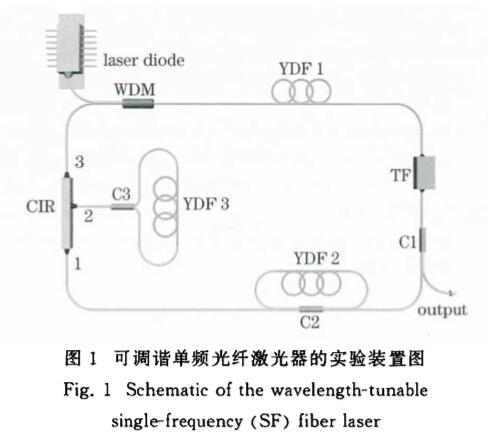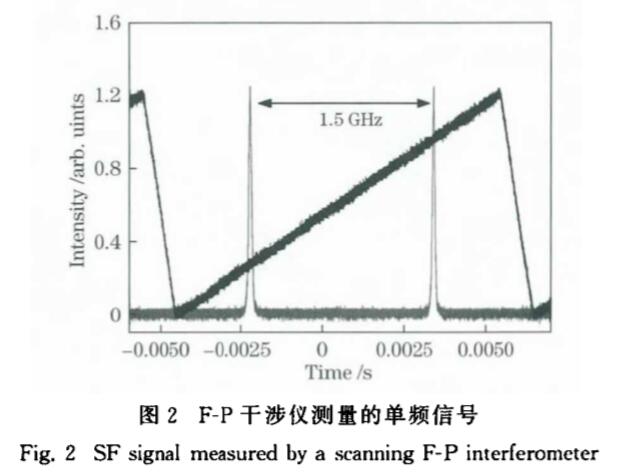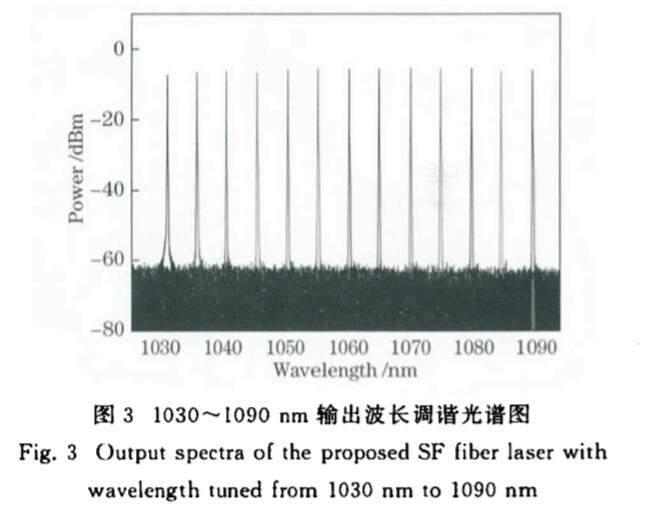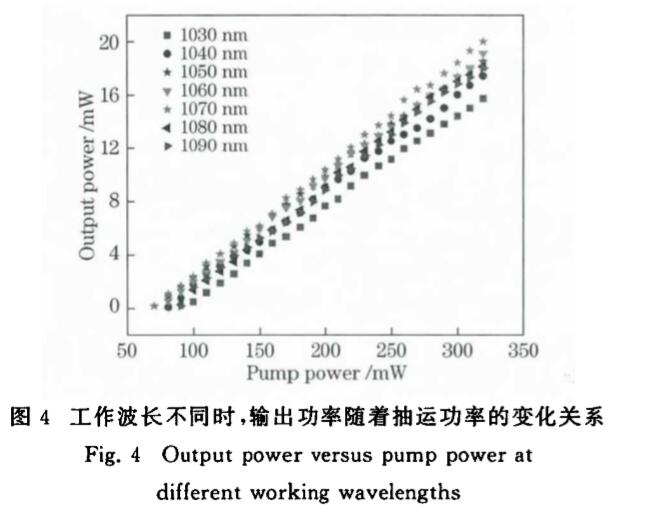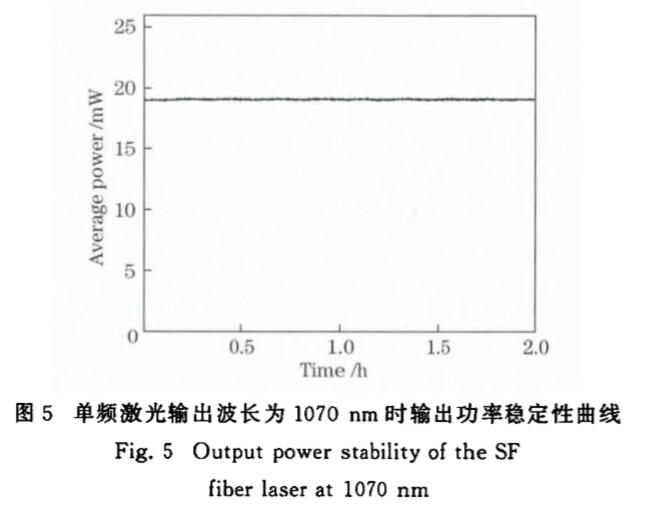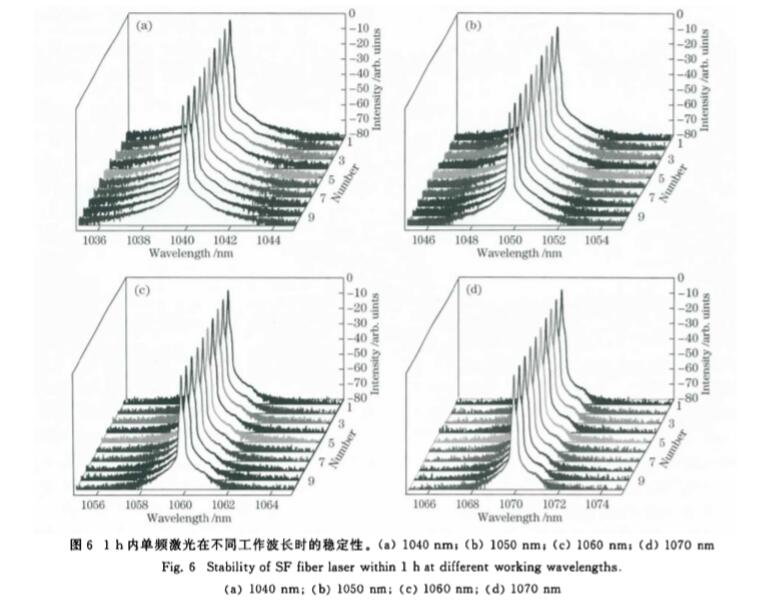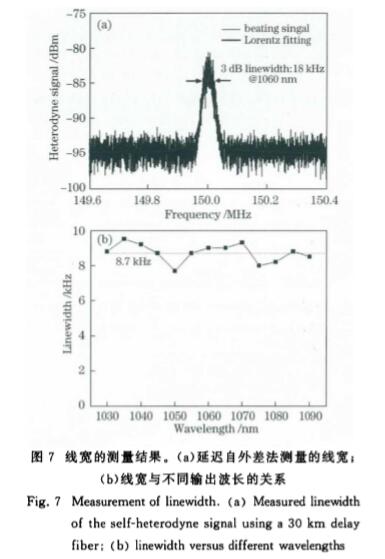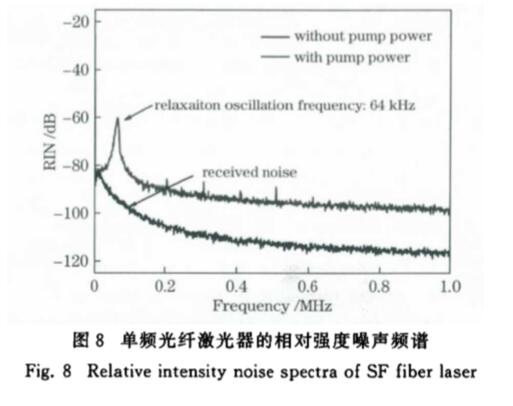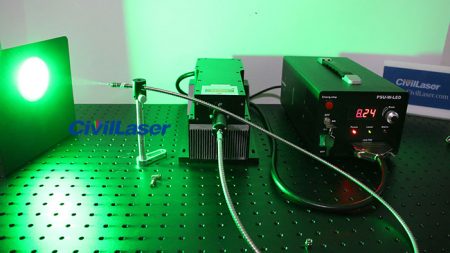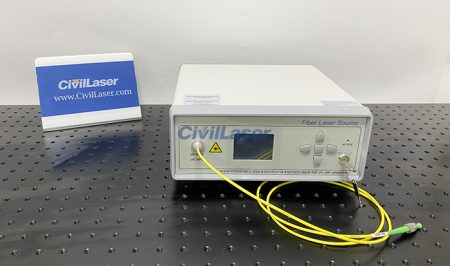Abstract The tunable single-frequency (SF) narrow-linewidth fiber laser with all-fiber complex cavity structure is designed, which is composed of an optical fiber tunable filter, a high-precision ring filter, and a fiber loop mirror. A 980-nm semiconductor laser is used as the pumping source, and the ytterbium-doped fiber is employed as the gain medium and saturable absorber, then a wide-spectrum tunable single-frequency narrow-linewidth laser output from 1030 nm to 1090 nm is successfully realized. When the pump power is up to 300 mW, the output power is 18.5 mW and the slope efficiency is 7.95% at the wavelength of 1070 nm. There is no mode hopping phenomenon within 1 h, and the standard deviation of power stability is less than 1 %. When the pump power is 200 mW, the linewidth is measured by the delay self-heterodyne method, and the average line width in the wavelength tuning range is 8.7 kHz, and the relaxation oscillation frequency is 64 kHz.
Introduction
Single-frequency fiber lasers have excellent optical characteristics such as small line width, low noise and long coherence length. They have wide application prospects in the fields of gravity wave detection, microwave photon and fiber sensing, and wavelength tunable single-frequency fiber lasers have The characteristics of wide-spectrum single-frequency, in the fields of metrology, biomedicine, spectroscopy, etc., have attracted the research interest of many researchers. At present, ultra-short linear cavity, linear cavity and annular cavity can realize single-frequency narrow linewidth laser output. (8) Ultra-short linear cavity is difficult to achieve wide-range tuning of wavelength due to its ultra-short cavity length and wavelength limitation of fiber-optic Bragg grating (FBG). The linear cavity is caused by the spatial hole burning phenomenon in the gain fiber. In the multi-longitudinal mode state; the annular cavity belongs to the traveling wave cavity, which avoids the hole burning effect caused by the linear cavity, and can insert the appropriate mode selection component and the wavelength tuning device to realize the output of the tunable single-frequency fiber laser “” (2) . There are many techniques for wavelength tunable generation, such as changing the center wavelength of FBG by stress or temperature to achieve single-frequency laser wavelength tunable, unpumped doped fiber saturable absorbers and cascaded filter devices, etc., but these The tunable single-frequency laser realized by the method has the disadvantages of narrow tuning range, large device loss, high cost, etc. In 2008, Zhang et al. reported the Sagnac ring using 3.5 m unpumped bait fiber as self. Inductive FBG filters combined with tunable Fabry-Perot (FP) filters for 45 nm tunable single-frequency fiber laser output; in 2013, Feng et al. used a fiber-optic ring (1-ring) filter to limit The number of longitudinal modes in the laser cavity, another double coupler fiber ring (2 rings) is used to ensure that there is only one longitudinal mode oscillation in the cavity, and the single-frequency output of the fiber laser is realized by step-by-step filtering. Tunable FBG for wavelength selection, achieving 30 nm tunable single-frequency laser output; in 2015, Lu et al. used 1.5 m unpumped fiber as saturable absorber to form Sagnac ring junction The dynamic grating, the center wavelength by changing the temperature of the FBG is used to achieve a frequency tunable single fiber laser; 2016, Feng and other mouth. The 10 nm tunable single-frequency laser output is achieved by stretching to change the center wavelength of the FBG while embedding a dual coupler fiber loop filter in another fiber loop filter. In 2017, Yeh et al. used a 10 cm fiber-doped fiber (YDF) and an optical fiberscope as interferometer filters to obtain a single longitudinal mode output of the laser and a 30 nm tunable single-frequency laser output through a tunable bandpass filter.
Based on the annular cavity, a tunable single-frequency narrow-linewidth fiber laser with tunable bandpass filter, high-precision ring filter and fiber loop mirror (LMF) is designed. The 980 nm semiconductor laser is used as the pumping source. The mirrored fiber is used as the gain medium and the unpumped saturable absorber in the cavity respectively. Through the precise adjustment and optimization of the cavity type, the stable width of 1030-1090 nm is successfully realized. The spectrum can be tuned to single-frequency narrow linewidth laser output. There is no mode hopping within 1 h of continuous operation, and the power instability is less than 1%. When the pumping power is 200 mW, the linewidth measurement is performed by the delay self-heterodyne method, and the average line width is 8.7 kHz in the wavelength tuning range, and the relaxation oscillation frequency is 64 kHz.
2 Experimental Devices and Principles
The experimental setup for tuning a single-frequency fiber laser is shown in Figure 1. A 980 nm semiconductor laser with a pumping power of 600 mW is used as the pumping source, and the pumping light is output from the pigtail via a 980/1060 nm wavelength division multiplexer (WDM). Coupling into the cavity to pump a 80 cm-length fiber with a length of 80 cm [Yb501, Corative, Canada, the concentration of the mirror (atomic fraction, the same below) is 0.021, the numerical aperture is 0.13], and the pumping light passes through 3 dB respectively. Tunable bandpass filter with 1 nm bandwidth, high precision filter (HFRF, consisting of 80% coupling: 2% 2X2 coupler C2 and 1.5 m unpumped gain fiber) and fiber loop mirror Coupling ratio is 50%: 50% of 1X2 coupler C3, three-terminal circulator (CIR) and 2 m length of unpumped gain fiber], tunable bandpass filter for multiple longitudinal modes in the cavity Mode suppression and wavelength tuning are performed, and then the number of modes in the cavity is suppressed by a high-precision filter. Finally, the single longitudinal mode in the cavity is selected by a fiber loop mirror. The three-port of the circulator is connected with one end of the wavelength division multiplexer to form a tunable single-frequency fiber laser composite annular cavity structure. In order to ensure that the light remains unidirectionally transmitted during the transmission, the circulator is 3 to 2 The end has a 45 dB isolation. The resulting tunable single-frequency laser is output by a 30% port of coupler C1 with a coupling ratio of 30%: 70% between the tunable filter (TF) and the high precision filter. Since the gain fiber has broadband absorption, and the fiber loop mirror can dynamically induce the grating filter to dynamically track the wavelength output of the tunable filter, the filter composed of them can be used for the wavelength tunable fiber laser, and can obtain a wider Tuning range.
The laser cavity tunable filter, high precision filter and fiber loop mirror can reduce the number of longitudinal modes of vibration in the cavity. Through the filtering of these three devices, a stable wavelength tuning single frequency output can be obtained. The tunable filter is not only used to achieve a wide range of wavelength tuning, but its 1 nm 3 dB bandwidth effectively suppresses many of the modes produced by the stimulated radiation of the mirrored fiber, reducing the number of longitudinal modes that oscillate within the cavity. The high precision filter consists of a fiber optic ring and an unpumped fiber YDF 2 . After passing through the tunable filter, the light enters a coupler with a coupling ratio of 50%: 50%, in which one light is coupled into the fiber ring and its transmittance is
Splitting ratio formula for coupler; g is the gain of the optical fiber loop; 3 is the angular frequency of the light field; r = 2k / a fsr delay time, a fsr = c / “is the free spectral range, c = 3X108. m/s is the speed of light, L|=2.3m, which is the length of the high-precision filter. The fiber loop mirror is composed of the Sagnac ring and the unpumped fiber YDF 3. The light passes through the circulator to enter a coupling ratio of 50%: 50%. The coupler is divided into two paths, and the two channels of the same amplitude and polarization are oppositely interfered in the YDF3, so that the fiber loop mirror forms a dynamic grating. The half-height full-width bandwidth of the dynamic grating is
Where / is the coupling coefficient of the dynamic grating; input light wavelength = 1060 nm;
fiber refractive index % = 1.45; dynamic grating length L = 2 m; YDF 3 refractive index change △ “V2X10T. Therefore, △ / ‘<14 MHz, this value is less than 11.8 m cavity length determined by the longitudinal mode interval of 18 MHz, indicating that the laser is in single longitudinal mode operation.
3 Analysis and Discussion of Experimental Results
Figure 2 shows the single-frequency signal characteristics measured by the scanning F-P etalon. The characteristics of the single-frequency laser were experimentally observed using a scanning F-P etalon (SA210, Thorlabs, USA) and an oscilloscope (DSO9104A, Agilent Technologies, USA). The scanning F-P standard has a free spectral range of 1.5 GHz and an accuracy of 200, which shows that the standard has a resolution of 7.5 MHz. The black sawtooth wave represents a voltage cycle and the red curve represents the number of single vertical modes over a ramp voltage cycle. It can be seen from Figure 2 that there are two single longitudinal modes in a sawtooth ramp voltage cycle, which form a smooth envelope. Even if one mode is expanded, no other modes will appear, and there is no mode jump and mode competition. The phenomenon proves that the laser fully realizes single-frequency laser operation.
The operating wavelength of the fiber optic tunable filter is controlled by a computer program, and a continuous single-frequency laser of different wavelengths is output. The constant pumping power is 300 mW and interval is measured by Yokogawa spectrometer (AQ6370C, Yokogawa, Japan, resolution: 0.02 nm). The output spectrum of a tunable single-frequency fiber laser for 5 nm is shown in Figure 3. It can be seen that this experiment successfully achieves continuous tunability of the output wavelength of 1030-1090 nm, its signal-to-noise ratio is greater than 50 dB, and no mode hopping and mode competition is observed when the control wavelength is tuned. Stable 1030-1090 nm continuous tunable single-frequency laser output.
In the experiment, the continuous single-frequency laser output power with different pumping powers at different operating wavelengths was tested (Fig. 4). It can be seen from Figure 4 that when the operating wavelengths of the lasers are different, the corresponding slope efficiency and output power are also different. The output characteristics of the tunable single-frequency laser at 1070 nm when the pump power is 300 mW are studied. At this time, the single-frequency laser output power reaches the maximum value of 18.5 mW, and the slope efficiency reaches 7.95%. The gain of the radiation spectrum of this laser medium at 1030 nm is stronger than other operating wavelengths, and the single-frequency output laser should have the maximum gain factor and laser output slope efficiency in this band. However, the experimental results show that when the slope efficiency is large, the operating wavelength of the continuous single-frequency laser is also large, mainly because the spontaneous emission of the shorter wavelength of the laser emission is absorbed again by the doped fiber, resulting in a single-frequency output at 1030 nm. The output power and slope efficiency of the laser did not reach a maximum.
In the experiment, the MAESTRO power meter produced by Gentec of Canada was used to study the stability of single-frequency fiber laser output power at 1070 nm. Power sampling was performed by setting the sampling time interval to 1 s and the time length to 2 h. Figure 5 shows the single-frequency fiber. The output power stability curve of the laser continuously working for 2 h, the power instability is less than 1%, indicating that the single-frequency fiber laser is in stable operation.
Wavelength Stability and Signal-to-Noise Ratio Stability of Single-Frequency Fiber Lasers As shown in Figure 6, wavelength stability within 1 h was measured at 5 min intervals in a room temperature environment. As can be seen from Fig. 6(c), when the wavelength of the optically optically tunable filter is set to 1060 nm, the spectral center wavelength does not change significantly. It can be seen from the calculation that the instability of the wavelength resolution is less than 0.02 nm; the optical signal-to-noise ratio fluctuation is less than 0.22 dB. The fluctuation of the wavelength offset and the optical signal-to-noise ratio is caused by the change of pumping power and ambient temperature. At the same time, the wavelength stability of the wavelengths of 1040 nm [Fig. 6(a)], 1050 nm [Fig. 6(c)], and 1070 nm [Fig. 6(d)] are measured, and their operating wavelengths and optics can be obtained. The stability of the signal to noise ratio is high.
The tunable single-frequency fiber laser output linewidth is measured using a 30 km single-mode delay fiber and a delayed self-heterodyne method. Figure 7(a) shows a continuous single-frequency fiber laser output operating at 1060 nm at a pumping power of 200 mW. Line width. Since the linewidth of the true single-frequency laser output is half the line width of the heterodyne signal curve, the linewidth of the single-frequency laser can be calculated to be about 9 kHz. In order to obtain the linewidth results of other wavelengths of single-frequency laser output, the measurement of 13 wavelength line widths is performed [Fig. 7(b)], and the average line width is 8.7 kHz by averaging, which indicates that the tunable Single-frequency lasers can achieve very narrow spectral linewidths over a very large range.
The relative noise intensity of a single-frequency fiber laser was measured using a photodetector (1611, Newport, USA) with a bandwidth of 3 dB and a maximum cutoff frequency of 1 GHz and a radio frequency spectrum analyzer (MS2724C, ANRITSU, Japan). When the pump source has no input power, the relative noise intensity (RIN) curve (received noise) of the spectrum analyzer is shown in the black curve in Figure 8. When the pumping power of the pumping source is 200 mW, the peak value of the relaxation oscillation frequency is about 64 kHz (the red curve in Fig. 8). The relaxation oscillation is due to the dynamic energy exchange process between the pumping field and the laser signal field. . By comparing the relative noise at a frequency of 0 to 1 MHz with the received noise, it is found that when the frequency is greater than 200 kHz, no other noise components are observed in the relative intensity noise spectrum of the single-frequency fiber laser.
4 Conclusion
A tunable single-frequency narrow-linewidth fiber laser with an all-fiber composite ring cavity structure is designed by using optical components composed of a tunable bandpass filter, a high-precision ring filter and a fiber loop mirror as filter elements. The 980 nm semiconductor laser is used as the pumping source. The Dode fiber is used as the gain medium and the unpumped saturable absorber in the cavity respectively. Combined with the optical isolation of the three-port circulator, the laser is unidirectionally transmitted in the cavity and then passed. The computer program controls the operating wavelength of the fiber optic tunable filter, and then outputs continuous single-frequency lasers of different wavelengths, successfully achieving a stable wide-spectrum tunable single-frequency narrow-linewidth laser output of 1030-1090 nm, when the pumping power is 300. At mW, the output power at the wavelength of 1070 nm is the largest, 18.5 mW, and the slope efficiency is 7.95%. There is no mode hopping within 1 h of continuous operation, and the power instability is less than 1%. When the pumping power of the pumping light is 200 mW, the line width is measured by the delay self-heterodyne method, and the average line width is 8.7 kHz in the wavelength tuning range, and the relaxation oscillation frequency is 64 kHz.

